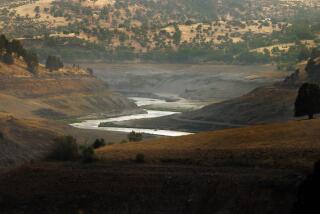Pennsylvania Shad Runs Reborn, One Bucket at a Time : Fish: Cut off from ancestral spawning grounds by dams, they are being scooped up and returned to the Susquehanna River.
Eighty years after a 55-foot high dam cut them off from their ancestral spawning grounds, record numbers of American shad are being returned to the Susquehanna River in Pennsylvania, wildlife officials say.
More than 10,000 shad have been scooped by bucket out of the river below the Conowingo Dam in Maryland this spring and released about 50 miles upriver. And biologists predict more than 15,000 will be trapped and released by the time the spawning season ends in mid-June, a 90 % increase over last year.
In 1972, the first year of the Conowingo fish lift program, only 182 shad were trapped and released.
Still, the increase over the years pales in comparison to the millions of shad that migrated up the Susquehanna before four new dams virtually ended the spring shad runs on the East Coast’s longest river basin.
The dams stretch from Conowingo north to the York Haven Dam near Harrisburg, Pa., and are operated by four power companies. The Holtwood Dam, built in 1910, limited shad runs to the lower 25 miles of the river.
In the 1970s, pollution was blamed for a decline in the shad population along the East Coast. But the runs have increased dramatically in recent years in rivers such as the Delaware, where water quality has improved.
In 1980, when the state of Maryland banned shad fishing, there were fewer than 5,000 American shad in the upper basin of the Chesapeake Bay, federal Fish and Wildlife Service officials say. Last year there were 75,000.
But federal and state officials agree that the costly lift program has a long way to go before shad are plentiful in the Susquehanna, which flows into the Chesapeake, and a 10-year fishing ban is lifted.
“The numbers are improving steadily. We’re showing a 50% per year improvement in stock size,” said Richard St. Pierre, the Fish and Wildlife Service’s Susquehanna River coordinator. “We’re talking about a few thousand fish compared to millions years ago.”
St. Pierre has charted the progress of shad in the Susquehanna since the early 1980s, when state and federal authorities began pressuring the power companies that own the dams to help bring back the fish.
The owners of the Holtwood, Safe Harbor and York Haven dams eventually agreed, among other things, to spend $3.7 million to stock shad upstream and to find ways to help young shad make their way downstream.
But Philadelphia Electric Co., which has operated a fish lift at the Conowingo Dam since 1972, resisted pressure to build a permanent fish lift.
Finally, in December, 1986, the Federal Energy Regulatory Commission ordered the company to build a second lift. Construction on that facility, which will cost $12.5 million, began this spring. It is expected to be finished by the fall of 1991.
Philadelphia Electric Co. officials say the new lift will still require that shad be trapped and loaded into trucks, then hauled nearly 50 miles past the York Haven dam near Harrisburg. Once released, the shad will have more than 350 miles of unobstructed river to spawn.
After years of fighting the proposal, the power company has done an about-face, and is now vigorously working to bring back the shad, according to St. Pierre.
“They used to be the bad guys and now they’re the good guys,” he said. “We fought them hard and bitterly but they didn’t want to spend the money.”
Biologist Chris Freas, whose company, RMC Environmental Services, contracts with Philadelphia Electric, said the fish lift is actually like an elevator. He said the fish are drawn into a holding pool, lifted in a bucket and dumped into a sorting tank. The shad are then separated and put into transport tanks.
Freas said the lift someday will be able to trap and transport 1.5 million shad and 20 million river herring. And while he is excited about the progress in recent years, he realizes the battle is far from over.
“Ten thousand fish is great news but that’s a long way from a restored population of fish,” he said. “There’s still a long way to go. The ultimate goal is to restore 3 million shad to the base of the Conowingo Dam.”
Freas noted that the recent increase in shad catches may be due in part to favorable river conditions, with an optimal water flow and temperature.
“If we have four bad years of spawning we could be back to square one,” he said. “We can’t control Mother Nature.”
St. Pierre said the Conowingo fish lift program is only a stopgap measure. He said for shad to flourish, the owners of the other three dams must also build fish lifts.
“All three of them are working on plans to build passageways,” he said. “The next step will be to convince them to put together a construction schedule.”
Shad will only spawn in the rivers where they were born. It is therefore important to establish a population of young shad in the spawning areas, said Art Michaels, who edits “Pennsylvania Angler,” a Fish Commission publication.
More to Read
Sign up for Essential California
The most important California stories and recommendations in your inbox every morning.
You may occasionally receive promotional content from the Los Angeles Times.










